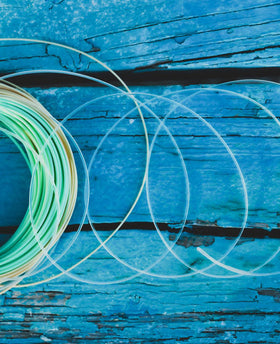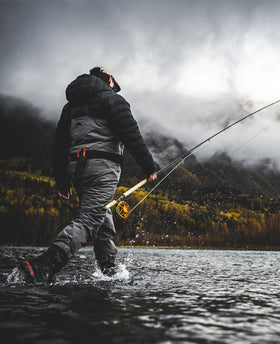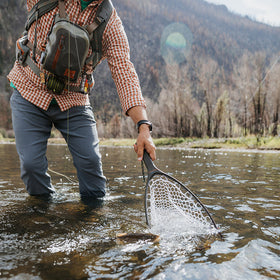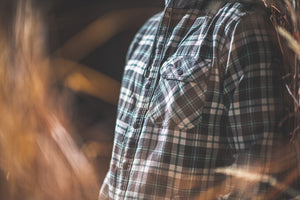
Streamer Fishing 301: Okay, The Fly Sort Of Matters
I mentioned in both the Streamer Fishing: 101 and the Streamer Fishing: 201 classes that your fly selection doesn’t really matter when you’re streamer fishing. Although this statement is factual, there are some aspects to your fly selection that actually do matter. When I’m out on the water I never know what type of streamer is going to pick up an eat. A couple of conditions I use to determine my streamer type are the water clarity, water temperature, time of year, flow levels, pressure of the fishery, and the type of fishery. In this article, we’ll be diving into the different types of streamers, how I select a particular streamer, and when I use them based on these conditions.

Big vs. Small:
Nowadays it seems everyone wants to throw bigger streamers in the hopes of catching that trophy trout. Trophy trout love to eat big meals, however, the big streamer approach has been working less and less throughout the years. The reason is everyone’s throwing big flies and after enough presentations, these trophy fish don’t respond to them in the same way they used to. Fishing pressure has made the big fish stop eating big meals, sort of. Large trout will still eat the natural big meals, the issue is our streamers have a hard time perfectly resembling these food sources. Due to this recent pressure, when we’re presenting larger streamers, fish often inspect the fly for long distances and will follow it all the way to the boat (or bank) to see if it’s real. When this is occurring, it is oftentimes beneficial to downsize your streamer so there’s less for the fish to inspect. Keep in mind, when referring to bigger streamers, think of the size range of a Dungeon or Headbanger Sculpin. Whereas their smaller counterparts can be anywhere from a Kreelex to a Mini Dungeon.
That being said, it’s usually not a bad decision to throw a large streamer. The best times to do so are when you’re targeting big trout, high water conditions, lower water clarity, and/or during warmer temperature periods observed during the summer. Don’t sleep on the spring and fall months either, trout are either very aggressive from the spawn or trying to pack on some weight after/before the long winter. Lake run fish will also eat bigger streamers once they enter the river because it’s a food source that they’re typically targeting in the lake. On the other hand, smaller streamers are a much more universal tactic and can be used throughout any season and water condition.

Color:
One of the most common questions we receive in the shop is, “what color should I be throwing?” I think this question is a lot simpler to answer than most think. I found color really doesn’t matter all that much, and it’s often the last factor I consider when picking a streamer. Some say that a lighter colored streamer should be thrown on a bright day, and a darker colored streamer should be thrown on a cloudy day. Although there is some truth to this, I don’t think this logic really gets you that far. I’ve caught a lot of trout on white streamers during cloudy days, as well as on black during sunny days. The only factor that really makes me consider my fly color is water clarity. Again, I’d like to point out that the actual color itself does not matter, but the type of color in particular water clarity does matter. For example, when water clarity is low I like to throw on either very bright or dark flies. Think yellow, chartreuse, red, purple, and black. I like these colors because it allows the fly to be more visible when it’s hard for the trout to see. On the other end of the spectrum, when water clarity is higher and the fish can see just about everything, I like natural colors. Think olive, tan, white, brown, and once again, black. When trout have the opportunity to fully inspect a fly as it moves through the water, matching their food source to the truest form possible is best for converting an eat.
This coloration scheme is merely a reach to find some type of categorization though. In reality, I'll fish just about every single color in my box until I get a bite. I’ve caught trout on bright sunny days, with great water clarity on yellow streamers. I also had the best streamer day of my life on an olive/white streamer during dirty water conditions. So take everything I’ve said about color with a grain of salt.
Profile:
This is truly the most important thing to consider when throwing streamers. The profile of the fly will dictate how the fly swims and ultimately if it gets eaten. Without getting too deep into this topic (because I could talk about this forever), I’m going to make this relatively general. The profile is dictated by the head and/or the entirety of the front hook build (the majority of streamers of the same back hook design). Deer hair, wool, and brush heads are generally going to push a lot of water and swim in a more stream-lined manner. Although these flies are often my favorite kind, they are rather aggressive and don’t always elicit strikes, particularly when the water is cold and/or in highly pressured waters. Another reason they don’t work very well in colder water is they’re head composition doesn’t allow for the fly to achieve depth effectively, even when fished with a sinking line. Instead, these are best used in the summer when big trout are sitting in shallow water waiting to ambush their prey. The other grouping of streamers are built with coneheads, fish skulls, and jig heads. The flies have less materials built into their head which allow for deeper water presentations, and more importantly, an erratic presentation. This is important to keep in mind for colder water and pressured fish because this erratic motion will “wake up” the fish from their winter rest, but also persuade them that the fly is real when they’ve seen a lot of presentations.
One way I like to look at these two types of streamers is the thicker head flies are best used to resemble a fleeing food source and are great when trout are actively hunting for a bigger meal. Whereas the thinner flies are best fished when trout want to spend less energy but can’t pass up an easy meal from a clearly dying or disorientated food source. Like every other factor I’ve talked about, the profile of the fly doesn’t always matter. This is merely a general guideline that can simplify your streamer choice during particular conditions. I would like to mention though, I’ve never found any other conditions but the water temperature to dictate my profile choice. Although, I have found that sometimes in stained water a fly that pushes a lot of water can be the ultimate factor to making a good day.

Some Examples of Selecting The Right Streamer:
Conditions: Dirty water, average flows, high water temperature, pressured floatable river, sunny day
Fly Choice: Smaller fly that is bright or dark in color with a thick head
Conditions: Slightly stained water, low flows, low water temperatures, pressured floatable river but has enough water for fish to hide, overcast day with some rain and snow
Fly Choice: Larger fly that is naturally colored with thin head
Conditions: Clear water, high flows, average water temperature, small water that is only accessible on foot, partially cloudy
Fly Choice: Smaller fly that is naturally colored with either type of head
Conditions: Good water visibility (not particularly stained or clear conditions), average flows, average water temperature, very large river that is only effectively fished from a boat, cloudy and windy
Fly Choice: Very large fly of any color with a thick head

We hope our Streamer Fishing 301 class helped you solidify your streamer fishing knowledge. Stay tuned next week to see our shop guys’ favorite streamer gear, flies, and approaches, as well as some additional tips. If you have any questions regarding this article or streamer fishing in general, feel free to email Xavier at xavier@goldenflyshop.com, or call the shop at 303-330-1292.
Read Streamer Fishing 101Read Streamer Fishing 201






Leave a comment